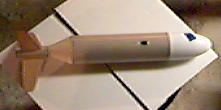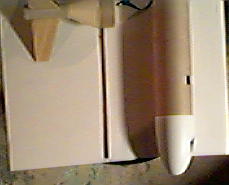Scratch DC-20 Digital Camera Rocket (light) Original Design / Scratch Built
Scratch - DC-20 Digital Camera Rocket (light) {Scratch}
Contributed by Morgan Hendry
| Manufacturer: | Scratch |
(Contributed - by Morgan Hendry)
 This project was an extension of my original
DC20 camera rocket. I has underestimated the finished weight of the
Initiator rocket camera, thinking it could be
lofted on an E to 500'. Big mistake. The finished weight was 2.2 lbs. An F
engine would be needed to reach the same altitude. I read a thread on RMR
concerning a light weight rocket camera booster. It described a Estes Phoenix
kitbash, using traditional white glue construction, that should be able to loft
a camera on a D or E engine. I thought about it and decided on another
approach. I would use a minimum diameter section for the 24mm motor tube (BT
50) and then a transition to a 2.6" diameter payload tube (BT 80). As I
was experimenting with a BT 80 nose cone with an open bottom, I found that the
electronics and about one half of the camera would fit inside a Fat Boy type
cone. In theory, I could create a nose cone payload section out of the nose
cone and a BT 80 transition section. Maybe for the next rocket...
This project was an extension of my original
DC20 camera rocket. I has underestimated the finished weight of the
Initiator rocket camera, thinking it could be
lofted on an E to 500'. Big mistake. The finished weight was 2.2 lbs. An F
engine would be needed to reach the same altitude. I read a thread on RMR
concerning a light weight rocket camera booster. It described a Estes Phoenix
kitbash, using traditional white glue construction, that should be able to loft
a camera on a D or E engine. I thought about it and decided on another
approach. I would use a minimum diameter section for the 24mm motor tube (BT
50) and then a transition to a 2.6" diameter payload tube (BT 80). As I
was experimenting with a BT 80 nose cone with an open bottom, I found that the
electronics and about one half of the camera would fit inside a Fat Boy type
cone. In theory, I could create a nose cone payload section out of the nose
cone and a BT 80 transition section. Maybe for the next rocket...
Construction began with the minimum diameter section. I glued (white glue) a BT 20/50 green centering ring in a piece of BT 50 body tube about 3" from one end. This will allow me to use Estes and Aerotech single use and reloadable motors. When that dried, I glued a 3/32" basswood BT 50/80 centering ring on the top of the motor tube (facing the front of the rocket). Below that, I glued a 1" piece of a BT 80 transition section, then another ring. The 2" long BT 50/80 transition section (made on VCP) was printed out, copied onto file folder material, cut out and glued on with white glue. Glue a screw eye in the top ring. I used scraps of basswood to stack on top of one another to make a thicker joint. This completes the lower section except for the fins (which I still have to do).
 I made a basswood bulkhead and glued a screw eye
into it (in the same way as before). This was glued 2" into a BT 80
section. I then rolled some corrugated cardboard (with one flat side pealed
off) into the section of BT 80. Where it overlapped, I made a cut and glued the
edges together to form a custom tube coupler. When it dried, I cut off a thin
strip and glued it into a the BT 80, using the lower section as a guide to push
it in the appropriate length. This will act as a thrust ring. I then took the
nose and cut the base off so that there was a 1" base. This will contain
the electronics and possibly some of the camera.
I made a basswood bulkhead and glued a screw eye
into it (in the same way as before). This was glued 2" into a BT 80
section. I then rolled some corrugated cardboard (with one flat side pealed
off) into the section of BT 80. Where it overlapped, I made a cut and glued the
edges together to form a custom tube coupler. When it dried, I cut off a thin
strip and glued it into a the BT 80, using the lower section as a guide to push
it in the appropriate length. This will act as a thrust ring. I then took the
nose and cut the base off so that there was a 1" base. This will contain
the electronics and possibly some of the camera.
The fins follow G Harry Stine's "high performance" clipped delta shape. Root chord is 48mm, tip is 24mm, and span is about 3" from root to tip. I cut them from 3/32" basswood and rounded them to a streamlined shape. They were then coated with thin CA and sanded smooth. They are VERY smooth. I have to say the first fin turned out to be one of the best I've ever made. To streamline the fin, I masked off the area 1/2" from the base of the fin with duct tape and sanded to a point on both sides. I then rounded the leading edge of the fin and smoothed the round leading edge into the sharp trailing edge. Not too hard.
I used the Estes fin alignment guide to hold the three fins on while the white glue dried. I then filleted the fins. All I have to do is add a shock cord and chute.
The predicted altitudes are (if the model is 10 oz. or less) 260' on a D12, 1000' on an Aerotech E15. And you don't even have to call air traffic control to launch!
Sponsored Ads
 |
 |











